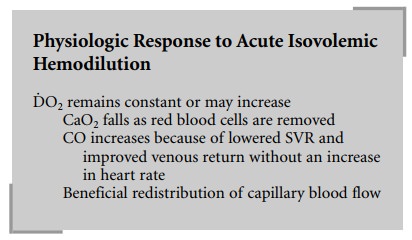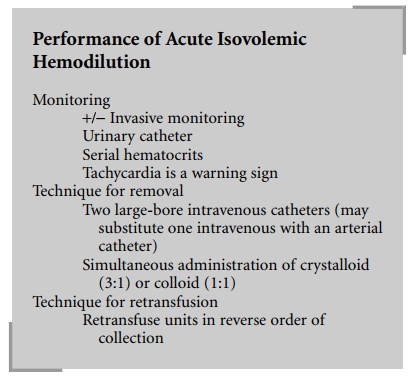Chapter: Clinical Cases in Anesthesia : Blood Replacement
How is AIHD accomplished?
How is AIHD accomplished?
AIHD is accomplished early in the perioperative
period, usually just after the induction of anesthesia. Blood is removed from
the patient via a large-bore intravenous catheter and stored in standard blood
bags containing anti-coagulant. An arterial catheter may be used for collecting
autologous blood, but we have found this to be less satis-factory.
Simultaneously, crystalloid, in a 3:1 ratio, or colloid (albumin, hydroxymethyl
starch, or dextran) in a 1:1 ratio is infused through another large-bore
intravenous catheter. The amount of blood to be removed can be calculated by
any of the formulas used to calculate allowable blood loss. We typically use
the following formula:

where
HctA = starting hematocrit
HctB = target hematocrit for hemodilution
EBV = estimated blood volume.
Typically, a target Hct in the mid to upper 20s
(25–27%) is used; this allows for substantial hemodilution yet allows some
margin of safety when blood loss begins to occur during surgery. In this
instance, HctA = 40%, EBV = 70 kg
70 mL/kg = 4,900 mL, and we will choose a HctB
= 27%. The formula then yields:
(40 − 27 × 4,900)/(40 + 27/2) = 1,900 mL
Thus, 3–4 units of the patient’s blood could be removed for later retransfusion.
As units of blood are removed, they are labeled and numbered consecutively. Blood
is retrans-fused in reverse order of collection. The first unit removed is the
least dilute and the richest in red cells, plasma factors, and platelets;
therefore, it should be the last unit retransfused.

Blood removed during hemodilution may be stored
in the operating room at room temperature for a maximum of 6 hours. Autologous
blood remaining after surgery may be stored in a blood bank refrigerator for
further use.

Invasive hemodynamic monitoring (arterial
catheter, central venous catheter) is not mandatory during isovolemic
hemodilution, but it facilitates serial Hct measurements and provides a guide
to fluid replacement. Because CO rises in AIHD without an increase in heart
rate, development of intraoperative tachycardia may indicate hypovolemia and
the need for retransfusion. A urinary catheter to monitor urine output as a
gauge of intravascular volume may be helpful. Also, replacing autologous blood
with 3 times the volume of crystalloid initiates a diuresis.
Related Topics